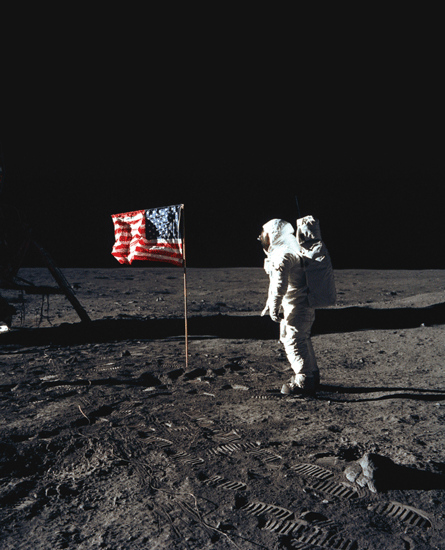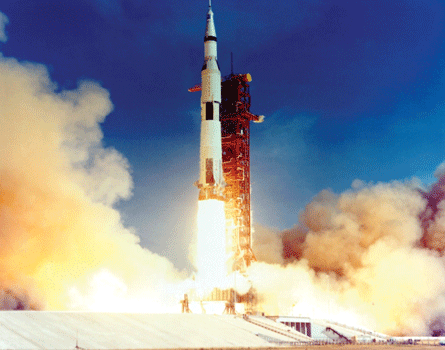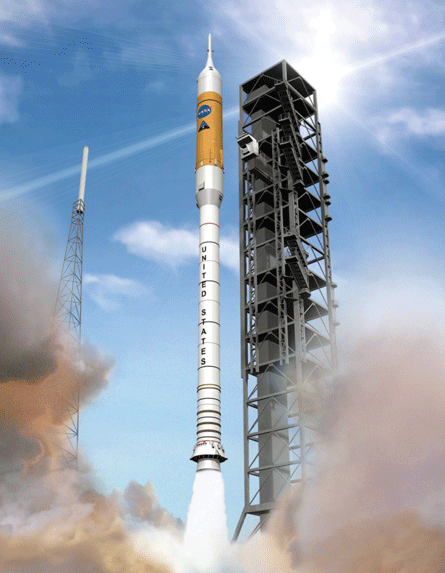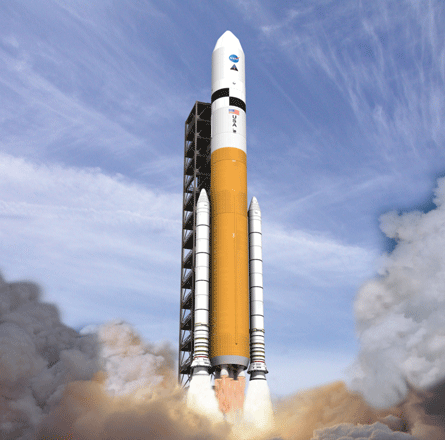In May 1961 President John F Kennedy's speech to a joint session of Congress launched what became humanity's most ambitious technical achievement with its promise that the USA would "commit itself to achieving the goal, before this decade is out, of landing a man on the Moon and returning him safely to the Earth".
That cold war race ended victoriously for the USA 40 years ago, but since then initiatives to recapture that sense of mission and awe have fallen foul of funding cuts.
 |
|---|
© NASA |
President Richard Nixon cancelled Apollo's future flights and ordered the Space Shuttle.
In 1984 President Ronald Reagan announced Space Station Freedom, but when orbital construction started four years late in 1998, with a vastly scaled back design, the renamed International Space Station had gained Russian involvement.
In 1989, on 20 July, the 20th anniversary of the Apollo 11 landing, President George H Bush announced his Space Exploration Initiative that was to be international in scope with co-operation for not only a space station but manned Moon and Mars missions.
But the Space Exploration Initiative would die as Congress balked at the huge budget hike NASA would need. Along the way smaller programmes for launch vehicle development, Shuttle II, Shuttle-C, the X-33 and Orbital Space Plane, among others, have come and gone.
So when Space Shuttle Columbia broke up on re-entry on 1 February 2003 president George W Bush's administration weighed up the value of human spaceflight and the national debate asked: is it worth the lives?
 |
|---|
© NASASaturn V has never been surpassed for power |
A year later NASA's Constellation programme came into being. Like the Apollo project, it was to build the rockets and spacecraft that would take astronauts back to the Moon and on to Mars. Designed with a 2020 target date for the seventh manned Moon landing, its price tag was meant to fit within a realistic NASA budget.
But from the start Bush's budget projections for it required above inflation increases year on year. It also required the retirement of the Shuttle in 2010 and the International Space Station by 2016.
From 2006 to 2008 NASA did not receive those above inflation increases and the situation was made worse due to Congressional delays in approving what funding the space agency was to get. Sufficient funding during crucial years in the development of the Constellation programme's rockets and spacecraft was not there.
The plan has been to develop the Ares I crew launch vehicle (CLV) rocket and the Orion crew exploration vehicle and to send it to the ISS for crew transport and cargo from September 2012. The Ares I would be capable of launching a lunar mission version of Orion, sending four astronauts to a polar outpost.
The outpost would be international in nature and other nations would provide equipment and even other cargo transport systems.
And while the international team of astronauts carry out their research at the Moon base, Orion would continue operating autonomously in lunar orbit for seven months. The outpost would consist of habitat modules, power stations, scientific payloads and pressurised rovers that would be delivered by a cargo version of NASA's Altair lunar lander.
LAUNCH VEHICLE
Altair would be launched by the Ares V cargo launch vehicle (CaLV) that would also loft the Earth departure stage (EDS) into low Earth orbit. The EDS would push to low lunar orbit a crew version of Altair - also Ares V launched - and Orion, which would dock with the EDS/Altair stack four days after the CaLV launch.
© NASAAres V would launch 40% more than Saturn V |
Michael Griffin, the NASA administrator from April 2005 who oversaw Constellation from its beginning to February 2009, when he stepped down, said at its unveiling: "This spacecraft and its systems will build upon the foundation of the proven designs and technologies used in the Apollo and Space Shuttle programmes, while having far greater capability...[It] will be able to carry larger and heavier cargos into space and allow more people to stay on the Moon for longer periods of time."
But mired by inadequate funding and vocal opposition over technical choices, the vision and Constellation still stand as the goal and route to achieve it, but for how much longer?
The first launch of Orion-Ares is now scheduled for March 2015, three years late, and conceptual design contracts for the Ares V and Altair are on hold because of a presidential review.
President Barack Obama's administration has come into power and, whether Constellation was a roaring success or not, it was going to at least review its progress to make this two-term Republican president's mission acceptable to the Democratic party's new leadership.
Announced in May, Obama's 120-day review, beginning in June, is being led by former Lockheed Martin chairman Norman Augustine, a veteran of NASA spaceflight reviews. He has a committee of scientists, engineers and former astronauts, Leroy Chiao and Sally Ride, to help him.
The work for Constellation is continuing while the review is under way and the plan is still to reach the Moon by 2020. The review's charter is not to question whether the USA should go to the Moon or exactly when to arrive - rather, it is how to get there.
The review committee's charter says: "The identification and characterisation of these [human spaceflight] options should address the following objectives: a) expediting a new US capability to support utilisation of the International Space Station; b) supporting missions to the Moon and other destinations beyond low Earth orbit; c) stimulating commercial spaceflight capability; and d) fitting within the current budget profile for NASA exploration activities."
Yet even before the panel has reported, the likelihood of a lunar return 11 years from now is questionable. NASA Space Shuttle Programme manager John Shannon says: "If the money is not there...are we going to propose something that is within the budget that we think we can go execute?"
Shannon spoke to Flight International after the first public meeting of Obama's review on 17 June. Then, Shannon proposed a Shuttle-derived Heavy Lift Vehicle (HLV), which members of his office believe meets the review's objective of "fitting within the current budget profile for NASA exploration activities".
It is one of three alternatives competing to replace Constellation, each of which saw presentations at the 17 June meeting. Two are launch provider United Launch Alliance's (ULA) Delta IV Heavy rocket and an independent proposal called Direct and its Jupiter booster. The third is crewed Commercial Orbital Transportation Services (COTS) launchers.
Two companies, Space Exploration Technologies (SpaceX) and Orbital Sciences are developing rockets and spacecraft to deliver cargo to the ISS for NASA. SpaceX has an agreement to develop a crewed version of its Dragon spacecraft, but it requires NASA to fund it. While Dragon may provide ISS transport, neither COTS company has any proposal for lunar missions.
Meanwhile Shannon emphasises that his office's HLV is more attuned to the lunar mission than the ISS flight with its 71,000kg (156,200lb) to low Earth orbit capability. His team estimates that HLV development costs will be $6.6 billion from 2010 to 2015, although Shannon admits that the figure needs to be independently verified.
TWO LAUNCHES
For a lunar mission the HLV would require two launches. One launch would orbit an Orion and its EDS and the second would send the lander and its EDS. The timing of such a double launch has dogged the Constellation programme whose ideas for Orion, EDS/Altair Earth orbit rendezvous have changed from up to 90 days between Ares I and Ares V launches to four days or even 90min.
Shannon's solution is to have no link between the two HLV launches because "if the lander used hypergolic fuels it could stay [in low lunar orbit] for as long as you want". The hypergolic fuels he is referring to are the likes of monomethylhydrazine, which has an ability to be stored for long periods in space.
But the HLV launched concept lander has a gross weight of 28,000kg compared with the Ares V's 45,000kg Altair. And Altair will use cryogenic propellants that, while harder to store, are lighter, delivering a payload improvement. Shannon's hypergolics are heavier, leading to a proportionally smaller payload for the HLV's lander.
In the ULA plan a human-rated Pratt & Whitney Rocketdyne RS-68A-powered Delta IV Heavy could launch in 2014 from a new dedicated launch site, Cape Canaveral pad 37C.
Michael Gass, ULA chairman, told the review committee on 17 June that the Delta IV Heavy could launch Orion "with a greater than 20% performance margin for both ISS and lunar trajectories that allows us to provide the shaping to eliminate concerns for [problems with] aborts.
The [Department of Defense] [PW&R] RS-68 engine upgrade we are working on is the enabler that provides this margin."
And he advocated evolved Delta IV Heavys that would launch from 2016. These evolutions would deliver a 40,000kg and then 70,000kg to LEO capability that is then extended, using new launch pads and new engines, for lunar missions needing more than 100,000kg orbited in one go.
He also said that the ULA Atlas V would be able to launch crew in 2013, but the government-owned company Aerospace, which conducts independent technical analyses, quashed the Atlas V as unfeasible due to its use of the Russian RD-180 engine in its presentation to the review later that day.
The Delta IV Heavy was also a subject of the same study by Aerospace. It found that for taking astronauts to the ISS, one of the reviews' objectives, a human-rated Orion launching Delta IV Heavy was cheaper to develop than the Ares rockets.
LUNAR ARCHITECTURES
If the Delta IV Heavy were to be selected, the Moon architecture would, like HLV, be very different to Constellation's. Architectures for lunar missions centred around evolved expendable launch vehicles such as Delta IV Heavy have been proposed within the pro-spaceflight community that do not use evolved 70,000kg- or 100,000kg-capable rockets.
They involve in-orbit propellant depots and a wider cislunar space commercial infrastructure, where orbiting tankers would enable upper stages to be refuelled to become EDS. And they could provide crewed spacecraft and landers with additional propellant so they can conduct translunar and transearth injection burns.
The Aerospace presentation did not report any assessment of the evolved 100,000kg or lighter Delta IV Heavy options, but did say that NASA had informed it that if Delta IV Heavy was chosen for crew transport then development not carried out for Ares I now would mean cost increases for Ares V later of up to $16 billion. The Aerospace study did not examine the cost and schedule of Ares I.
The Constellation programme presentation on 17 June was given by Hanley and his superior NASA exploration systems mission directorate associate administrator Doug Cooke.
It centred on progress to date and planned solutions to the high-profile technical challenges Ares I has, such as the oscillations from its five segment solid rocket booster first stage. But no reconfigured Ares vehicle alternatives were given.
Constellation programme manager Jeffery Hanley told the 17 June meeting: "We are undergoing a programme wide content review looking at the breadth of content to see if there are any economies we can find," to better match resources with the March 2015 goal of first Orion/Ares flight. Hanley also gave the committee a figure of $35 billion for the total cost of Orion, Ares I development to the first flight.
Space programme sources that have previously worked on the Ares rockets have told Flight International that they see another potential path for the Ares vehicles.
A possible cheaper and quicker alternative is a four-segment solid rocket booster first-stage Ares I, with the same upper stage, launching a lighter ISS-only Orion.
The solid rocket boosters and the upper-stage P&WR J-2X engine make up the important technology for a lunar return, so as long as the Ares I rocket is maintained, NASA retains key capabilities to build the Ares V, however far out into the future its development is pushed.
 |
|---|
© NASAAres I uses the Saturn V-derived J-2X engine |
And that could be some way away. President Obama's fiscal year 2010 budget's projections cuts Ares V funding down from Bush's FY2011 spending prediction of $365 million to $25 million. Obama's FY2010 Ares V spend is $25 million against the Bush plan for $24 million.
Another factor that makes the likelihood of significant development for Ares V before 2015 or even 2020 unlikely is the expected use of the ISS to at least 2020. The Augustine committee is looking at that and its subcommittee, headed by Ride, will report on the ISS option to Augustine's panel this month.
Last of all there is Direct's Jupiter rockets. The Direct team is a mixture of space programme workers and engineers and other specialists from outside the space industry.
The team's Jupiter-130 booster, which would launch Orion, is a Shuttle-derived in-line system using four segment solid rocket boosters, a core stage based on the external tank with three Space Shuttle main engines at its base.
Direct says it will cost $8.3 billion and could launch in September 2012.
The lunar version is the Jupiter-246 that has an upper stage that uses a P&WR J-2X or P&WR RL-10s. One architecture to go to the Moon considered by Direct using its Jupiter rocket requires two launches, one for Altair and Orion and the other for the EDS, which then all dock in Earth orbit.
"They have a viable rocket," says Shannon, "but I think they have underestimated their costs".
Whether the USA returns to the Moon in 2020 or whether it is beaten to it by the Chinese in 2030 will depend on the decisions of this president less than a year into his first term and by the actions of the US Congress in the years to come.
More than 12 months into his Moon programme, in September 1962, Kennedy spoke at Rice University, in Houston, Texas. He touched upon what it took to sustain a hold on distant shores, and in particular the shores of what 331 years previously was called the new world and would become the USA.
Referring to a quotation from an early settler of the Americas, Kennedy said: "William Bradford, speaking in 1630 of the founding of the Plymouth Bay Colony, said that all great and honourable actions are accompanied with great difficulties, and both must be enterprised and overcome with answerable courage."
See a gallery of images from the Apollo programme on AirSpace
Source: Flight International



























